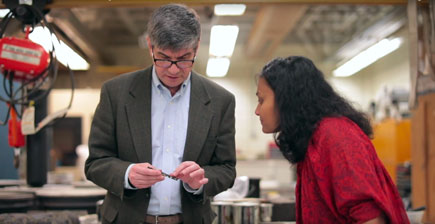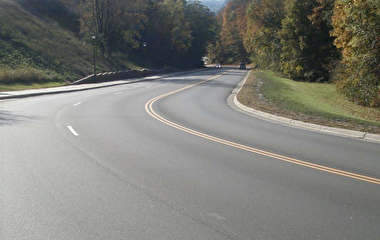Photo: Eve Daniels
Full-depth reclamation (FDR) of asphalt pavement is often used on rural roadways to reduce costs for materials and hauling. New research from the U of M indicates that FDR is also a good option for rehabilitating urban and suburban roadways and most likely outperforms traditional mill-and-overlay in cost and durability.
With FDR, road builders use trains of recycling equipment to pulverize, lift, grind, remix, and repave asphalt in a single pass. This recycling puts less demand on petroleum resources and new aggregate. Despite its benefits, FDR has yet to be adopted widely by city and county public works departments. In part, this is due to the challenge of using trains of equipment on urban and suburban roads that feature curbs, manholes, and driveways. Mill-and-overlay also has lower initial costs.
“Our goal was to provide evidence of FDR’s cost-effectiveness, guidelines for FDR project selection, and, ultimately, performance-based specifications,” says Mihai Marasteanu, a professor with the Department of Civil, Environmental, and Geo- Engineering (CEGE) and the study’s principal investigator.
Marasteanu and co-investigator Jialiang Le also sought to provide testing protocols, procedures for analyzing life-cycle costs of FDR compared with conventional rehabilitation methods, and ways to use the MnPAVE computer program to determine long-term performance expectations for FDR. The project was sponsored by the Minnesota Local Road Research Board and the Minnesota Department of Transportation.
Researchers began by taking samples of asphalt pavement from an FDR construction site in Victoria, Minnesota, before and after emulsion was added and created four asphalt mixes: one was a site sample with emulsion added on-site and compacted in the lab; the other three were dry mixes from the field mixed and compacted in the lab with various versions of the field emulsion. The samples were then subjected to several mechanical tests, and the results were used in computer simulations to evaluate FDR’s potential performance, design life, and life-cycle costs.
“When we compared the simulated life-cycle costs of FDR with known results for traditional mill-and-overlay mixtures, we found that FDR is more cost-effective over a 35-year period than traditional methods,” Marasteanu says. “In addition, mill-and-overlay must be redone every 18 years, causing more inconvenience and costs for road users than the longer-lasting FDR.”
The City of Shoreview has used FDR effectively by using individual machinery units rather than long, connected recycling trains. “This research helps us translate full-depth reclamation projects in Shoreview into hard cost-benefit, return-on-investment numbers,” says Mark Maloney, Shoreview’s public works director. “It validates what we’ve been doing and gives cities what they need to justify the cost of using FDR in urban settings.”
“Before, all we had was anecdotal information,” Marasteanu says. “Now we have laboratory testing methods that are easy to use and can be incorporated in performance prediction models.”



